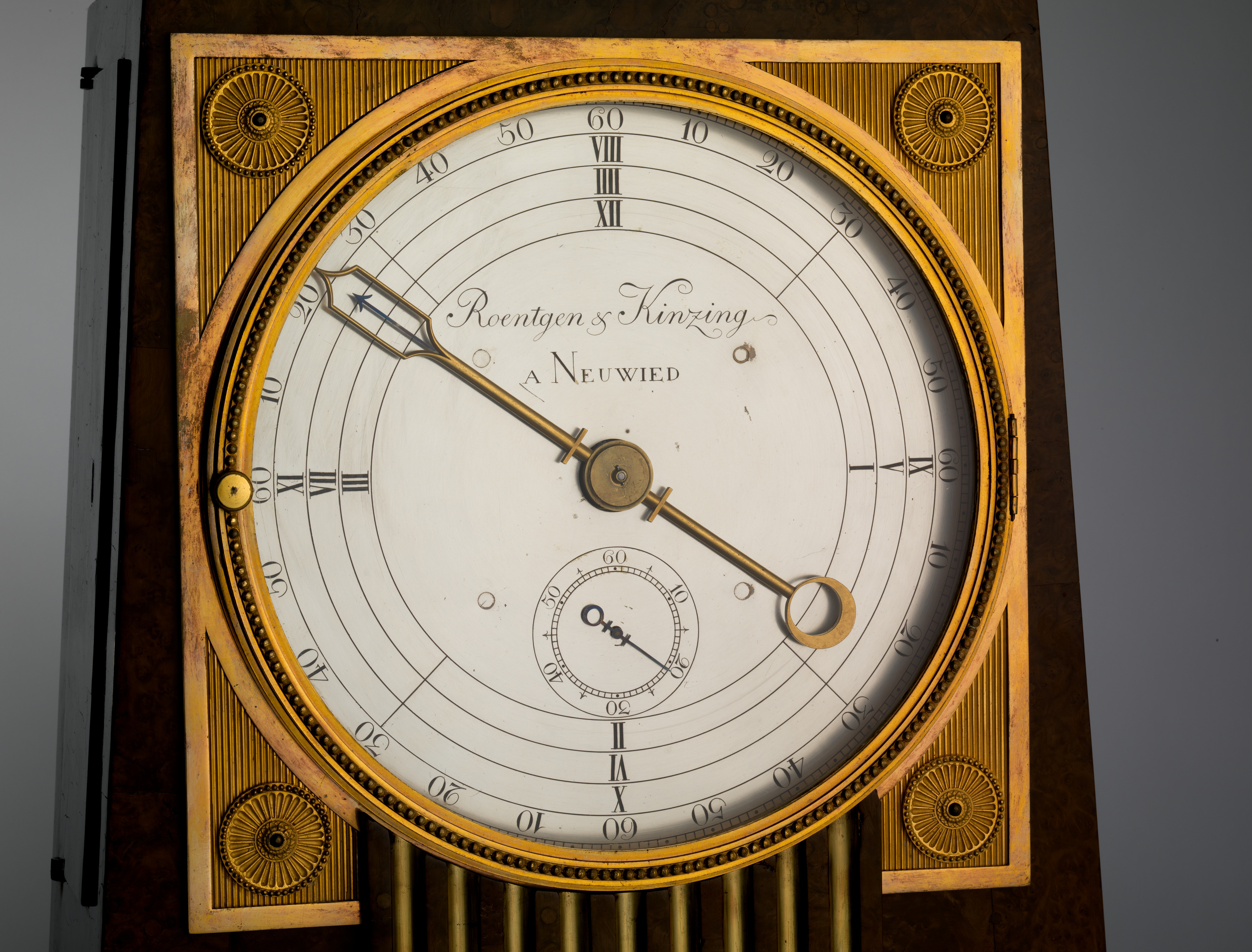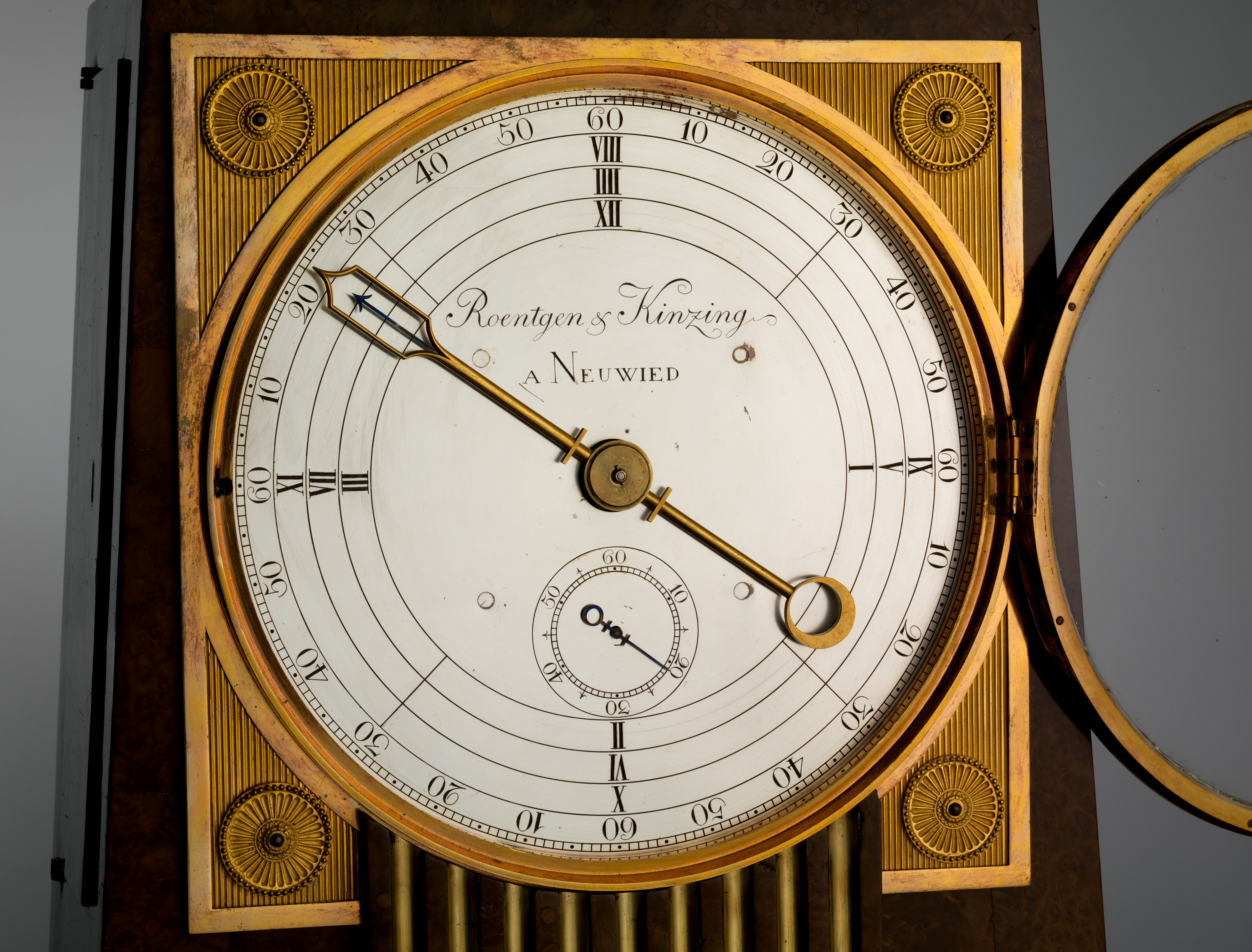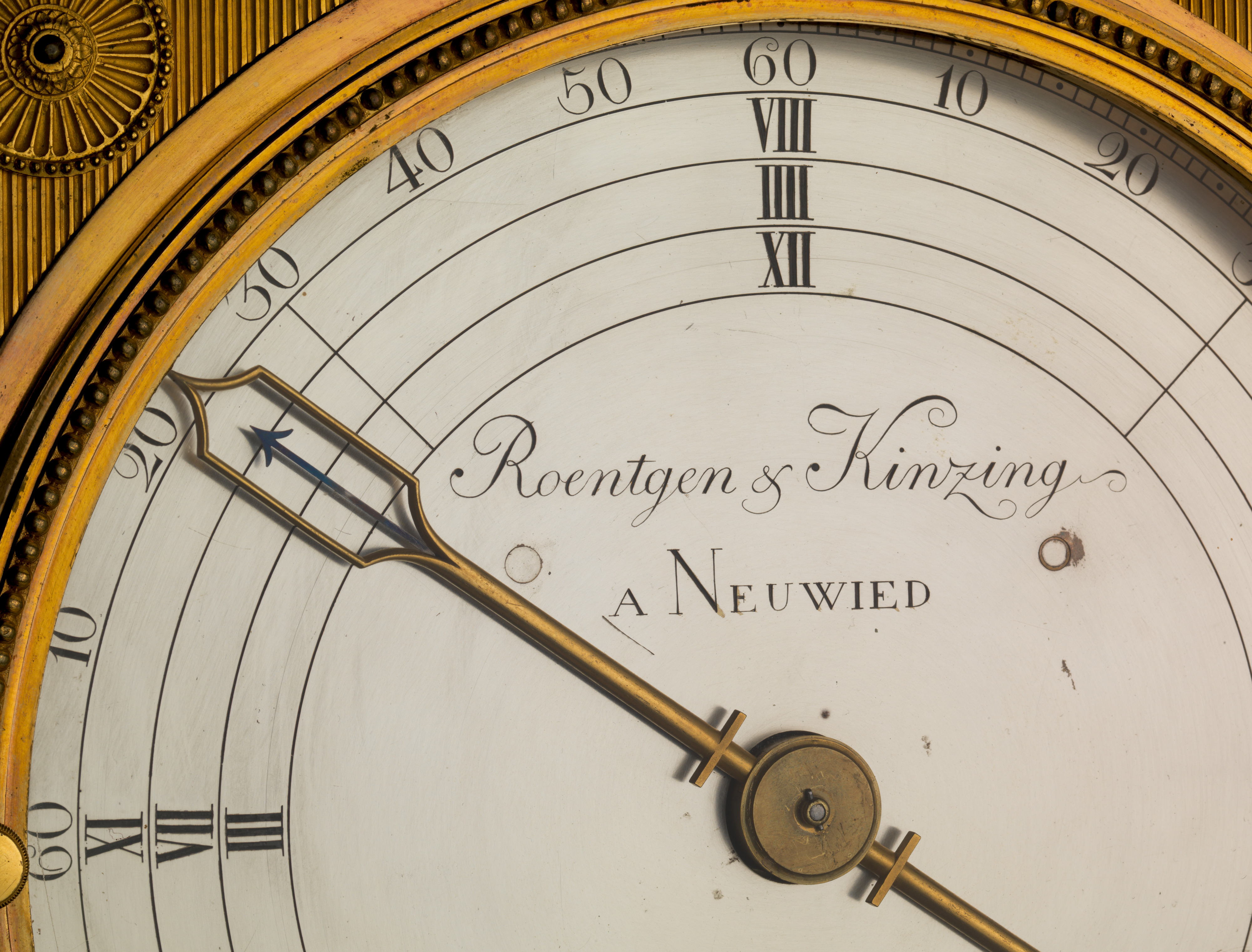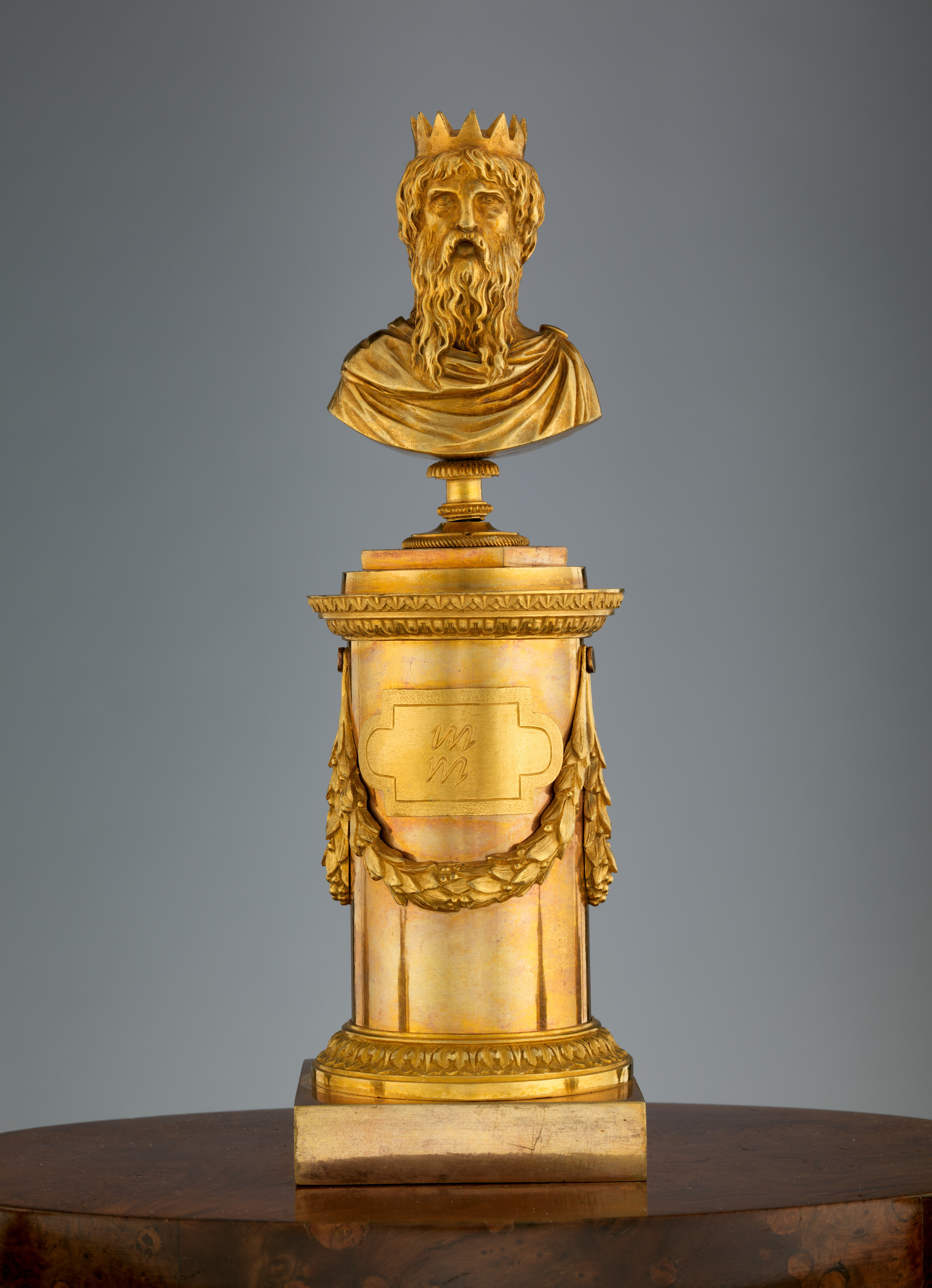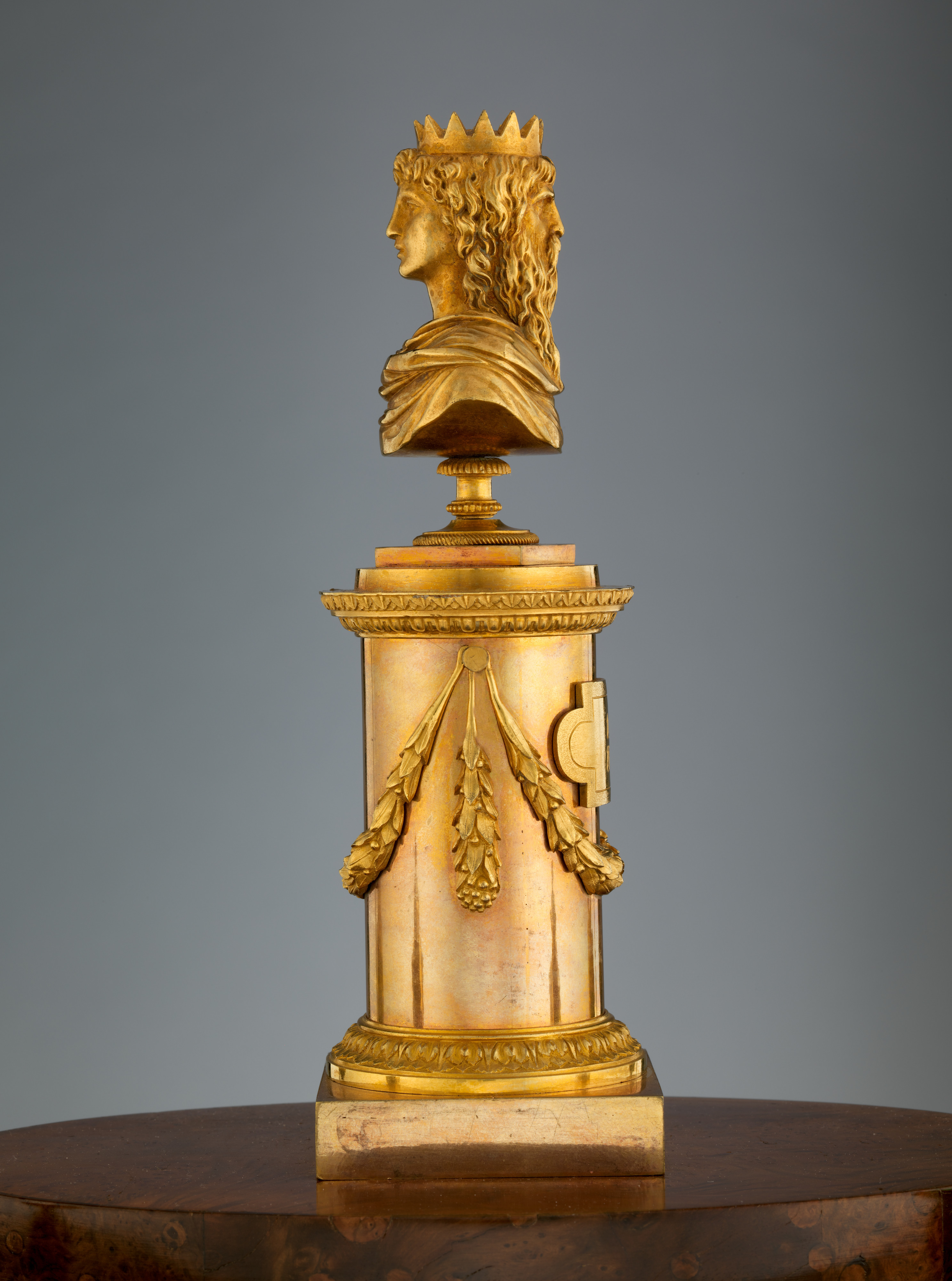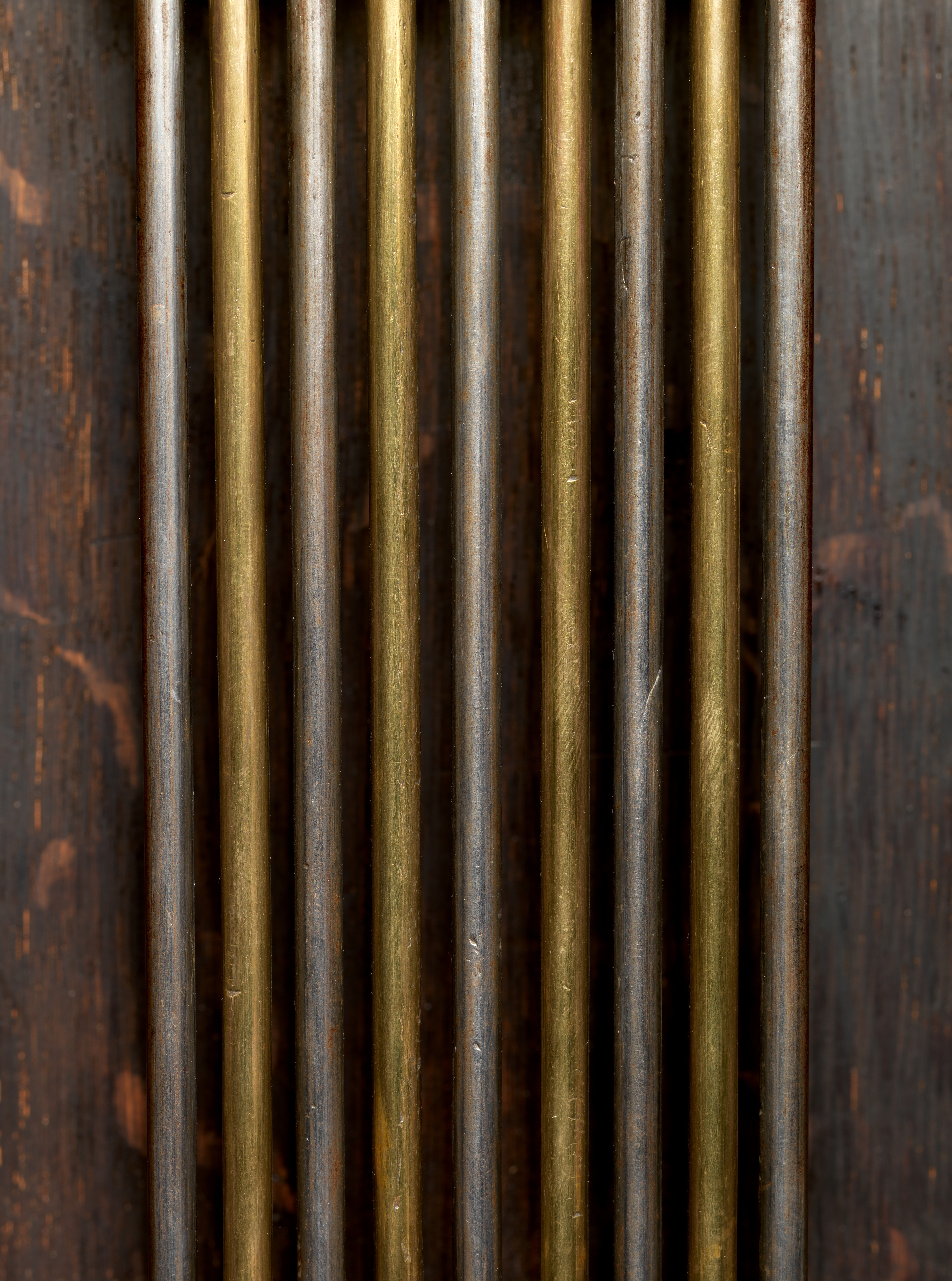Obelisk clock with a Franklin movement
Case maker: David Roentgen German
Clockmaker: Peter Kinzing German
The distinctive appearance of this clock model sets it apart from Roentgen’s earlier Chippendale-inspired longcase clocks (see acc. no. 1975.101; Wolfram Koeppe. Extravagant Inventions, the Princely Furniture of the Roentgens. Exh. cat. The Metropolitan Museum of Art, New York; 2012. New York and New Haven, 2012, cat. 26) and the monumental ones with musical devices (see Roentgen-Museum, Neuwied inv. no. 4055 and The Nemours Foundation inv. no. 83-27; ibid., cats. 63, 66). The unusual shape of this case, which is reminiscent of a tall pyramid or obelisk (see also ibid., cat. 57), efficiently accommodates the arc of the pendulum as it swings. Decorated with brass-filled grooves, the long pilaster strips under the dial serve as the door to the clock’s movement. Behind the dial is a square gilded plaque with disks in the spandrels. On the stepped top, four gilded urns surround a gilded bust on a high pedestal. The cases’ exquisite craftsmanship radiates the ideal of neoclassical restraint while producing a subtle effect of great luxury. About two dozen clocks of this type are known to survive, some with conventional movements. Nearly all of David Roentgen’s important timepieces were made in collaboration with Peter Kinzing, a Neuwied clockmaker who supplied Roentgen with other sophisticated mechanisms and instruments for his furniture, including musical ones (see Roentgen-Museum, Neuwied inv. no. 455; ibid., cat. 63). Kinzing’s contribution here is an improvement on the famous clock with a three-wheel movement, a four-hour spiral ring dial, and a single minute hand invented in the 1760s or 1770s by Benjamin Franklin.[1] Kinzing’s dial has three concentric rings rather than Franklin’s spiral (a modification that had already been made by Franklin’s friend James Ferguson); however, like Franklin’s dial, each ring is divided into four sections, the outside edge is marked with the 240 minutes that make up four hours, and every tenth minute is numbered. It was difficult to determine the correct hour on Franklin’s dial, and it was probably Kinzing who designed a mechanism that solved the problem: a hand visible through an aperture in the minute hand points to the appropriate concentric ring.[2]
The multitalented Benjamin Franklin became known in European intellectual circles during the 1740s through his scientific publication, and with the general public after 1752, when he performed his famous kite experiment proving that lightning is electricity. He traveled in Germany and spent the years 1776–85 in Paris, where he was lionized by the French, who were fascinated by his scientific novelties. He may even have met Roentgen and Kinzing, who made several business trips to Paris during those years. As Ian. D. Fowler has observed, "It is very probable that Franklin’s fame and popularity inspired Roentgen and Kinzing to begin constructing a clock à la Franklin."[3]
Roentgen sold various examples of the present clock in Russia; one is still in the collection at Pavlovsk palace.[4] In addition to many other pieces of Roentgen furniture, Philippine von Hessen-Kassel owned a Franklin clock, which Count Georg Ernst Levin von Wintzingerode inherited and eventually left to her Württemberg relatives (see ibid., cat. 59 and the entry for cat. 55).[5] In October 1797 the town council of Leipzig bought from Roentgen a Franklin clock with similar crowning mounts, which were stolen in the second half of the twentieth century.[6]
Roentgen’s pyramidal case design was stylistically ahead of its time. It inspired cabinet- and clockmakers far into the nineteenth century, when woods popular in the Biedermeier period replaced the precious woods and mounts used by Roentgen.[7]
[Wolfram Koeppe 2012]
Footnotes:
I thank Gerd Hermann for identifying the wood.
1. I am very grateful to Ian D. Fowler for sharing with me his vast knowledge of Franklin clocks in general, and of the versions made in Neuwied in particular, in an email of December 11, 2011. A thorough and fascinating study of the history of the Franklin clock is Ian D. Fowler and Eugen Denkel. "Franklin-Uhren aus Neuwied." In Kinzing & Co. 2003, pp. 36-51. [English translation available online at http://www.historische-zeitmesser.de/fachartikel/three_wheel.html].
2. Ibid., pp. 40-41, for information about Franklin and Ferguson originally published in 1773.
3. Ibid., p. 43.
4. See Alexandra Alexejewa and Rifat Gafifullin in Krieg und Frieden: Eine deutsche Zarin in Schloss Pawlowsk. Exh. cat. Haus der Kunst, Munich; 2001-2. Munich and Hamburg, 2001.
5. In Johann Heinrich Tischbein the Elder’s portrait of Landgravine Philippine von Hessen-Kassel (Hessische Hausstiftung, Museum Schloss Fasanerie, Eichenzell/Fulda, Germany (FAS B 27); Wolfram Koeppe. Extravagant Inventions, the Princely Furniture of the Roentgens. Exh. cat. The Metropolitan Museum of Art, New York; 2012. New York and New Haven, 2012, fig. 85), the round table with a marble top (possibly covered in baize or felt in the picture) is probably listed in her estate inventory, together with about a dozen other Roentgen objects; see Heinrich Jobst Graf von Wintzingerode. "‘Unsere von Roentgen zu Neuwied verfertigt Pendule’: Die Schwedter Hohenzollern als Kunden David Roentgens." In Roentgen in Gotha 2008, pp. 26-27.
6. Hans Huth. Abraham und David Roentgen und ihre Neuwieder Möbelwerkstatt. Deutscher Verein für Kunstwissenschaft. Berlin, 1928, pl. 59, and Hans Huth. Roentgen Furniture: Abraham and David Roentgen, European Cabinet-Makers. London, 1974 [Also published in German as Abraham und David Roentgen und ihre Neuwieder Möbelwerkstatt. Munich, 1974], ill. no. 204 (with original ornaments on the top; Dietrich Fabian. Kinzing und Roentgen, Uhren aus Neuwied: Uhren, Uhrenmöbel, Musikinstrumente, Spielwerke. Leben und Werke der Uhrmacherfamilien Kinzing und der Kunstschreiner Abraham und David Roentgen. Bad Neustadt an der Saale, 1984, p. 331, no. 70. Its appearance is recorded in a watercolor by Carl Werner of 1858 (Stadtgeschichtliches Museum, Leipzig); see Andreas Büttner in Andreas Büttner, Ursula Weber-Woelk, and Bernd Willscheid, eds. Edle Möbel für höchste Kreise: Roentgens Meisterwerke für Europas Höfe. Exh. cat. Stadtische Galerie Mennonitenkirche and Roentgen-Museum, Neuwied, and Schloss Engers, Neuwied-Engers; 2007. Neuwied, 2007, p. 235, no. 46.3.
7. Angus Wilkie. Biedermeier. New York, 1987, p. 180, fig. 180; Architectural Digest, November 1991, p. A23 (the veneer on the case of the illustrated clock is of light birch burl wood and dark ebonized pearwood).
Due to rights restrictions, this image cannot be enlarged, viewed at full screen, or downloaded.
This artwork is meant to be viewed from right to left. Scroll left to view more.


